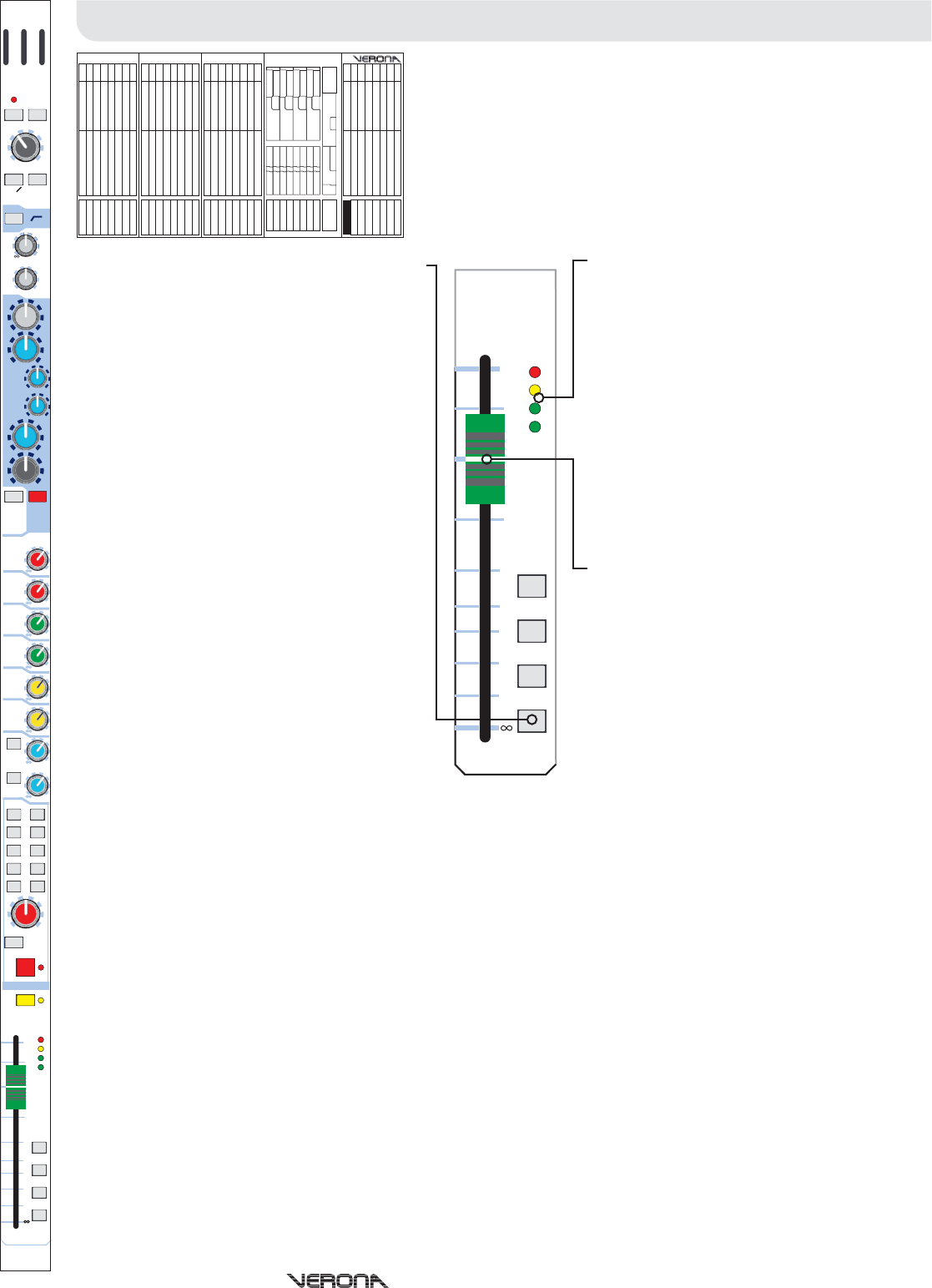User Guide
Table Of Contents

Mute 1,2,3 & 4
Channels Reason
- The Verona has four (4)
automute busses that can be controlled
from the centre section of the console. To
assign an input channel to an automute,
switch in the desired mute switch.
Commonly, these are used to mute similar
channels, for example:
Drum Mics Allows the engineer to
mute the whole drum kit
at once.
Choir Overheads Allows the engineer to
quickly remove all choir
mics at once
Orchestra Parts Allows the engineer to
zone mics together (e.g.
Brass, Strings, etc.) and
mute sections together if
they were not playing.
Note that if any assigned automute or the
channel mute is activated then the channel
will be muted until all assigned automutes
and the channel mute are removed (i.e. the
mutes work like a logical OR where any
single or combination of mutes will mute the
channel output).
4 LED Meter
Channel Fader
- Each input channel
contains in-channel monitoring
allowing the user to monitor the input
signal without the need for using the
PFL.
The in-channel meter is especially
useful when setting the microphone
gain of a channel. Also, as the, meter is
post-EQ, it is possible to see the effect
that the channel equalisation has upon
the level. It may be necessary to turn
the input gain down when excessive EQ
is used to prevent the channel from
overloading.
Note: The LED meter is Post-Insert and
EQ but Pre-Fader and Mute.
- The channel fader
allows for continuous adjustment of the
channel level from off (-inf) to +10dB.
At 0dB, the output of the channel to the
Stereo, Mono and Group busses will be
at unity (i.e. no boost or cut in level
from the input).
Operators Manual - Page 18
-18
0
12
18
mute 1
mute 2
mute 3
mute 4
10
10
5
5
0
20
15
30
40
Multi Function Module hints & Tips
I want direct outs for recording but multi function channels don’t have any . . .
I’m running monitors from FOH and I've run out of auxes for effects . . .
The multi function channels don’t have a specifically labelled direct output BUT, if you are using a microphone
input and don’t need to use the insert channel, you can insert a standard unbalanced quarter-inch jack lead into
the insert point and use this as a direct output. This will work on the condition that you do not activate the insert
point on the channel strip (the insert switch) as this will cause signal to the channel to be lost.
To see for yourself why this works, look at the block diagrams later in the manual.
To add effects to a mono mic input on a multifunction channel, use the insert send of the channel into the effects
unit input and the stereo outputs of the effects unit into the stereo line inputs of the same channel on the Verona.
Use the mic gain for the mic and the line gain for the effect return level. Now the aux sends and channel fader will
control both the mic level and effects return level.
Multi Function Input ChannelsMulti Function Input Channels
mic gain
100
-15
-15
-15
-15
+15
+15
+15
+15
+30 +45
+60+15
mic
padpower
48V -15
mono
wide
stereo
0
0
0
0
0
0
0
0
+6
+6
+6
+6
+6
+6
+6
+6
image
line gain
treble
bass
stereo
hi-pass
80Hz
pan
c
l
+20
0
r
groups
pan
mute 1
mute 2
mute 3
mute 4
aux 1
aux 2
aux 3
aux 4
aux 8
mono
groups
stereo
1-2
5-6
7-8
3-4
pre
pre
aux 7
aux 6
aux 5
O
-18
0
12
18
eq
on
eq
aux pre
off
MIDAS
ins
300
500
600
3k
8k
1k2
1k5
hi-mid
lo-mid
SOLO
MUTE
10
10
5
5
0
20
15
30
40










